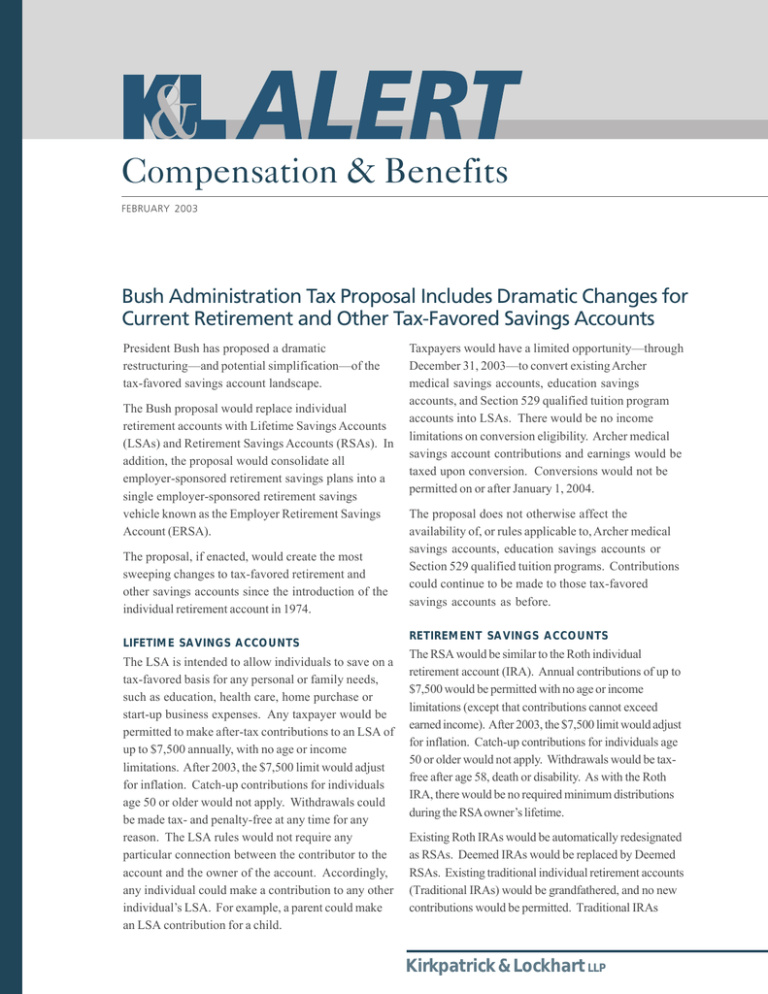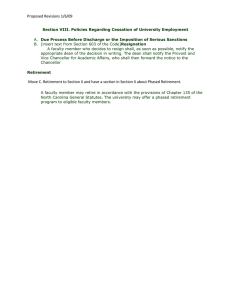
Compensation & Benefits
FEBRUARY 2003
Bush Administration Tax Proposal Includes Dramatic Changes for
Current Retirement and Other Tax-Favored Savings Accounts
President Bush has proposed a dramatic
restructuring—and potential simplification—of the
tax-favored savings account landscape.
The Bush proposal would replace individual
retirement accounts with Lifetime Savings Accounts
(LSAs) and Retirement Savings Accounts (RSAs). In
addition, the proposal would consolidate all
employer-sponsored retirement savings plans into a
single employer-sponsored retirement savings
vehicle known as the Employer Retirement Savings
Account (ERSA).
The proposal, if enacted, would create the most
sweeping changes to tax-favored retirement and
other savings accounts since the introduction of the
individual retirement account in 1974.
LIFETIME SAVINGS ACCOUNTS
The LSA is intended to allow individuals to save on a
tax-favored basis for any personal or family needs,
such as education, health care, home purchase or
start-up business expenses. Any taxpayer would be
permitted to make after-tax contributions to an LSA of
up to $7,500 annually, with no age or income
limitations. After 2003, the $7,500 limit would adjust
for inflation. Catch-up contributions for individuals
age 50 or older would not apply. Withdrawals could
be made tax- and penalty-free at any time for any
reason. The LSA rules would not require any
particular connection between the contributor to the
account and the owner of the account. Accordingly,
any individual could make a contribution to any other
individual’s LSA. For example, a parent could make
an LSA contribution for a child.
Taxpayers would have a limited opportunity—through
December 31, 2003—to convert existing Archer
medical savings accounts, education savings
accounts, and Section 529 qualified tuition program
accounts into LSAs. There would be no income
limitations on conversion eligibility. Archer medical
savings account contributions and earnings would be
taxed upon conversion. Conversions would not be
permitted on or after January 1, 2004.
The proposal does not otherwise affect the
availability of, or rules applicable to, Archer medical
savings accounts, education savings accounts or
Section 529 qualified tuition programs. Contributions
could continue to be made to those tax-favored
savings accounts as before.
RETIREMENT SAVINGS ACCOUNTS
The RSA would be similar to the Roth individual
retirement account (IRA). Annual contributions of up to
$7,500 would be permitted with no age or income
limitations (except that contributions cannot exceed
earned income). After 2003, the $7,500 limit would adjust
for inflation. Catch-up contributions for individuals age
50 or older would not apply. Withdrawals would be taxfree after age 58, death or disability. As with the Roth
IRA, there would be no required minimum distributions
during the RSA owner’s lifetime.
Existing Roth IRAs would be automatically redesignated
as RSAs. Deemed IRAs would be replaced by Deemed
RSAs. Existing traditional individual retirement accounts
(Traditional IRAs) would be grandfathered, and no new
contributions would be permitted. Traditional IRAs
Kirkpatrick & Lockhart LLP
could be converted into RSAs at any time. There would
be no income limitations on conversion eligibility.
Deductible contributions and earnings would be taxed
upon conversion. However, taxpayers that convert their
Traditional IRAs prior to January 1, 2004 would be
permitted to spread the tax over a four-year period.
■
Integration with Social Security and cross-testing,
which are commonly used to funnel greater
benefits to highly compensated employees, would
be prohibited.
■
The top-heavy rules would be eliminated.
■
W-2 compensation would be the only permissible
definition of compensation for any purpose.
■
The definition of highly compensated employee
would be revised so that individuals with prior
year compensation above the Social Security
wage base would be considered highly
compensated.
EMPLOYER RETIREMENT SAVINGS ACCOUNTS
The ERSA would replace all employer-sponsored
retirement savings plans, including 401(k) plans,
SIMPLE 401(k) plans, 403(b) plans, governmental 457
plans, salary reduction simplified employee pensions
(SARSEPs) and SIMPLE individual retirement accounts.
The ERSA would be, essentially, a modified 401(k) plan
available to all employers, without restriction. The
ERSA would permit annual pre-tax contributions up to
the 401(k) plan limits ($12,000 for 2003, increasing to
$15,000 by 2006, and indexed to inflation thereafter),
plus catch-up contributions for individuals age 50 or
older ($2,000 for 2003, increasing to $5,000 by 2006, and
indexed to inflation thereafter). After-tax contributions
would also be permitted and would be taxed in a manner
similar to RSA contributions.
Existing 401(k) plans would automatically become
ERSAs. Existing 403(b) plans, governmentsponsored 457 plans, SIMPLE IRAs and SARSEPs
would be frozen.
The 401(k) average deferral percentage test would be
modified so that the ERSA would pass if the average
contribution percentage of nonhighly compensated
employees is at least 6% or the average contribution
percentage of highly compensated employees is no
more than 200% of the average contribution percentage
of nonhighly compensated employees. Alternatively,
an employer may avoid the average deferral percentage
test under a safe harbor similar to the existing 401(k)
plan safe harbor.
OTHER DEFINED CONTRIBUTION PLAN CHANGES
The proposal would also make the following changes
for all defined contribution plans, including ERSAs,
profit sharing plans, money purchase plans, and
employee stock ownership plans:
■
The coverage discrimination test would be
simplified by making the ratio percentage test the
only permissible way to pass. (The average
benefit test would be eliminated.)
ANALYSIS
It is, of course, difficult to predict whether the proposal,
or any significant portion of it, will become law. The
proposal has already encountered significant
opposition. However, if enacted, the proposal would
likely shift the retirement savings “balance of power”
from employer-sponsored savings plans to individual
savings accounts.
The LSA would presumably become the primary
savings account vehicle for most taxpayers since it
would have no eligibility restrictions and no
restrictions on distribution. The relatively high
$7,500 annual contribution limit could mean that few
taxpayers would have a need to save additional
amounts through RSAs, ERSAs, Coverdell education
savings accounts, Section 529 qualified tuition
programs or Archer medical savings accounts.
However, for those that do, the Bush proposal would
substantially increase the maximum amount of annual
tax-favored retirement savings. For 2003, a married
couple with sufficient income could contribute up to
$54,000 per year to a combination of LSAs, RSAs and
ERSAs ($58,000 if both spouses are age 50 or older by
the end of the year). Other savings needs could also be
addressed through Coverdell education savings
accounts, Section 529 qualified tuition programs and
Archer medical savings accounts, all of which would
continue to be available.
The employer-sponsored ERSA would still have
some relevance in individual retirement tax planning
as it would be the only vehicle through which
individuals could make deductible or pre-tax
retirement savings contributions. Depending upon
their financial circumstances, some taxpayers would
presumably prefer to save for retirement on a pre-tax
or deductible basis, even at the cost of paying taxes
on both contributions and earnings upon distribution
and even though ERSA savings would be subject to
much greater distribution restrictions than LSA or
RSA savings. Moreover, employer matching
contributions to an ERSA may create incentives for
taxpayers to choose ERSA contributions over LSA or
RSA contributions.
proposals, such as the elimination of integration with
Social Security, cross-testing and the average benefits
test, as well as the prohibition of non-W-2 definitions of
compensation, would reduce the ability of employers to
skew benefits to highly compensated employees.
However other changes, such as the modifications to
the average deferral percentage test, could result in
greater contributions by highly compensated
employees.
The ERSA and the defined contribution plan changes
in the Bush proposal would bring welcome
simplification and uniformity to employer-sponsored
defined contribution retirement plans. Some of the
None of the changes included in the Bush proposal
would affect qualified defined benefit plans.
MICHAEL A. HART
412.355.6211
mhart@kl.com
If you have questions or would like more information about K&L’s Employee
Benefit Plans/ERISA practice, please contact one of our compensation and benefits
lawyers listed below.
Boston
Stephen E. Moore
617.951.9191
smoore@kl.com
Los Angeles
William P. Wade
310.552.5071
wwade@kl.com
New York
David E. Morse
212.536.3998
dmorse@kl.com
Pittsburgh
William T. Cullen
Michael A. Hart
J. Richard Lauver
Charles R. Smith
Richard E. Wood
Linda B. Beckman
Douglas J. Ellis
412.355.8600
412.355.6211
412.355.6454
412.355.6536
412.355.8676
412.355.6528
412.355.8375
wcullen@kl.com
mhart@kl.com
rlauver@kl.com
csmith@kl.com
rwood@kl.com
lbeckman@kl.com
dellis@kl.com
San Francisco
Laurence A. Goldberg
Kathleen M. Meagher
Katherine L. Aizawa
415.249.1043
415.249.1045
415.249.1044
lgoldberg@kl.com
kmeagher@kl.com
kaizawa@kl.com
Washington
William A. Schmidt
Eric Berger
202.778.9373
202.778.9473
william.schmidt@kl.com
eberger@kl.com
®
Kirkpatrick & Lockhart LLP
Challenge us. ®
www.kl.com
BOSTON
■
DALLAS
■
HARRISBURG
■
LOS ANGELES
■
MIAMI
■
NEWARK
■
NEW YORK
■
PITTSBURGH
■
SAN FRANCISCO
■
WASHINGTON
...............................................................................................................................................................
This publication/newsletter is for informational purposes and does not contain or convey legal advice. The information herein
should not be used or relied upon in regard to any particular facts or circumstances without first consulting a lawyer.
© 2003 KIRKPATRICK & LOCKHART LLP.
ALL RIGHTS RESERVED.



